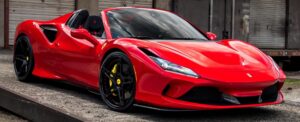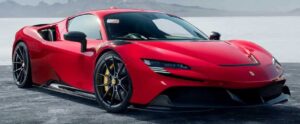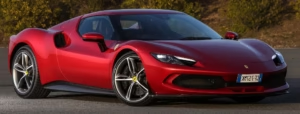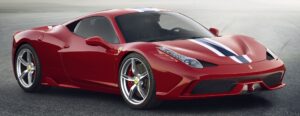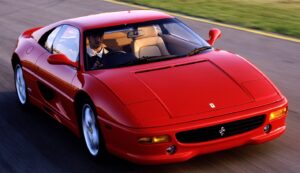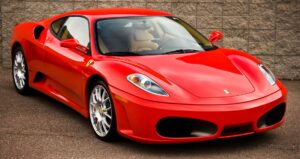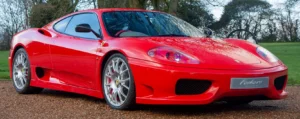Ferrari market update: Signs of stabilization
1. Ferrari market update: Prices stabilize, but is the shift here to stay?
2. Falling prices begin to level out
3. Models with stable or increasing prices
4. From uncertainty to stability
5. A market turning the corner?
6. Conclusion
Ferrari market update: Prices stabilize, but is the shift here to stay?
Over the past year, the Ferrari market has presented a mixed picture: some models have dropped in value, others held steady, and a few even climbed. But now, it seems like the entire market has hit pause.
So, are we at the end of the market correction—or on the edge of a new shift?
In this article, we’ll unpack the current state of the Ferrari mid-engine market, particularly in the US and Germany, and explore what it means for buyers, sellers, and collectors alike. Whether you’re looking to buy, sell, or just monitor values, this is the update you won’t want to miss.
Falling prices begin to level out
Ferrari 488
In the US market, 488 prices—especially for the Spiders and Coupes—dropped significantly between mid-2022 and mid-2024. But over the last six months, that trend has slowed. Coupes declined by only 4% and Spiders by 2.1% in the past year—compared to over 8% previously. Inventory data supports this stabilization, with cars selling more quickly.
In Germany, 488 Coupes dropped 4.2% and Spiders 3.8%, showing a similar bottoming pattern.
Ferrari F8
US Coupe prices fell by 4.3% last year, a statistically significant improvement from previous years. Spider prices, however, fell by 7.8%, continuing their prior trend. Interestingly, the Coupe market’s flattening is driven mainly by 2020 models with higher mileage.
In Germany, depreciation was slightly milder: Coupes fell 2.5% and Spiders 4.5%.
Ferrari SF90
The SF90 remains one of the fastest depreciating Ferraris, with prices down 15.7% for Coupes and 15.1% for Spiders. While the decline has slowed slightly, signs of a bottom are minimal. Only high-mileage Coupes (over 2,600 km) show weak signs of stabilization.
Ferrari 296
The newest addition to the lineup is still depreciating rapidly. US prices are down 16.4% for Coupes and 16.2% for Spiders. In Germany, Coupes fell by 11.6% and Spiders by 16.6%. Notably, German Coupes had more than twice the mileage of their US counterparts, possibly explaining the slightly softer depreciation.
Models with stable or increasing prices
Ferrari 458
This model remains a standout. Coupe prices dipped by 2%, while Spider prices surged by 6%—a statistically confirmed rise. All mileage segments in the Spider market reflected this increase. Sales velocity also improved, with only 20% of Spiders unsold after 3 months in March (compared to an average of 30%).
In Germany, prices were stable, with Coupes down 0.2% and Spiders up 0.2%.
Ferrari F355
Due to its small market, data on the F355 is more volatile. The automatic Spider market appears stable, hovering between €90,000 and €115,000. A year-over-year increase of 9.5% was observed, but not confirmed statistically. Thus, we consider this market steady rather than appreciating.
From uncertainty to stability
Ferrari F430
Previously uncertain, the F430 market now shows stabilization across all mileage bands. The market fell just 3.2% last year and has returned to pre-pandemic levels when adjusted for inflation. In Germany, prices increased by 0.7%, though this change isn’t statistically confirmed.
Ferrari 360
The 360 followed a similar path. Prices rose 1.7% last year in the US, but the increase isn’t statistically significant. High-mileage cars (over 56,000 km) continue to decline. Adjusted for inflation, prices are still 5% above pre-pandemic levels. In Germany, the market remained stable with a tiny 0.1% decline.
A market turning the corner?
When we combine data across all models:
-
Depreciating models like the F8 and 488 are seeing softer declines.
-
The SF90 shows minor signs of slowing, but still depreciates heavily.
-
The 296 continues to fall rapidly.
-
Previously uncertain models like the 360 and F430 are now stabilizing.
-
Resilient models like the 458 and F355 are holding strong, with some gains.
In fact, most Ferraris discussed here lost less than the market average for sports cars, which saw a year-over-year decline of 5%. The 296 and SF90 stand out as exceptions, with 15–16% drops—putting them among the top 25% of fastest-depreciating cars.
Conclusion
Is this stabilization just the natural result of aging vehicles? Or could it reflect buyer hesitation around newer hybrid Ferraris?
While we can’t be certain, the fact remains: hybrid models like the 296 and SF90 are depreciating faster than even traditionally high-depreciation GT models like the 812, which never exceeded 11% annual loss.
So, what does this mean for the future? Trends suggest continued stabilization for older models, but as always, external factors and new releases can shift the market quickly.
Inspired by the analysis of our friend @fourwheeltrader. Make sure you check his other videos https://www.youtube.com/@fourwheeltrader/featured.
Are you already a proud owner of a Ferrari? If so, check out our selection of parts for this car at the following link:
Photos sources: hdcarwallpapers.com, rileybusbym.pages.dev, edwardcotteeb.pages.dev, michaeldreeve.pages.dev, mycarheaven.com, autoevolution.com,








